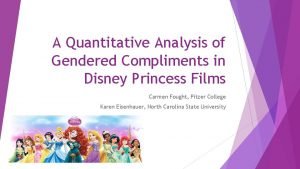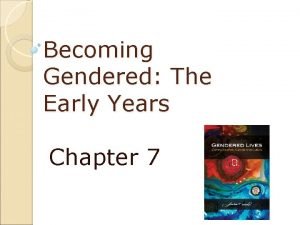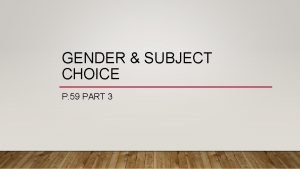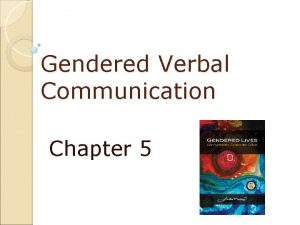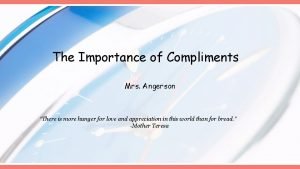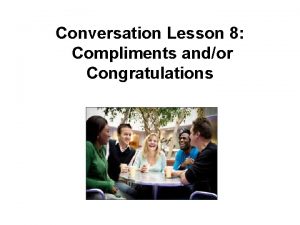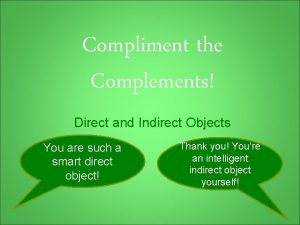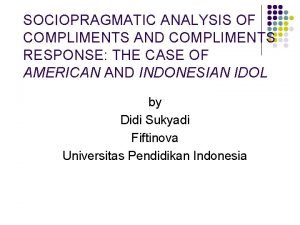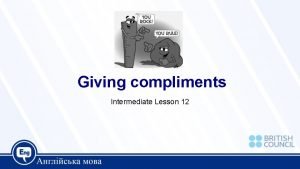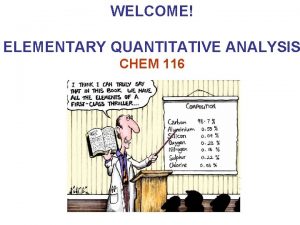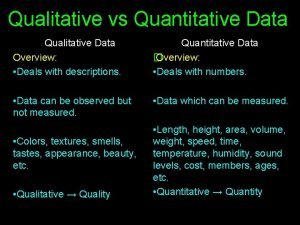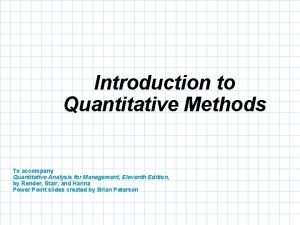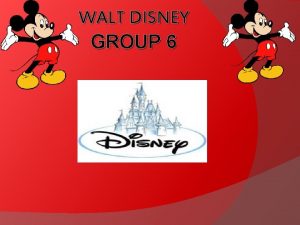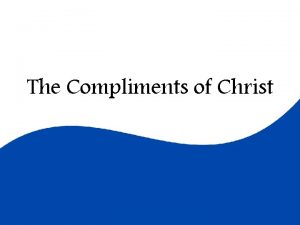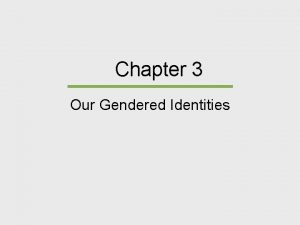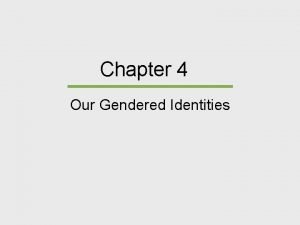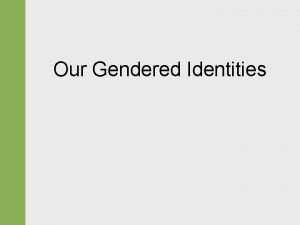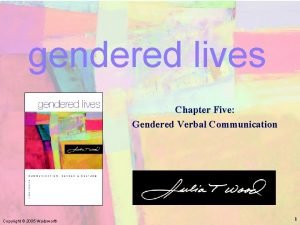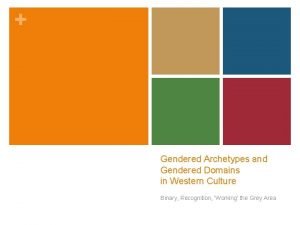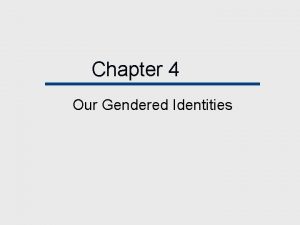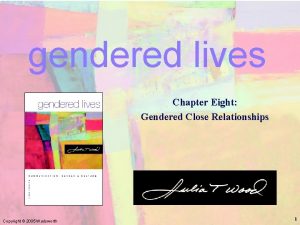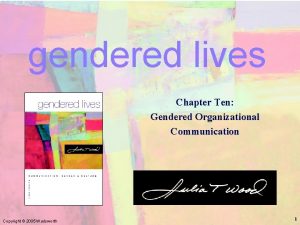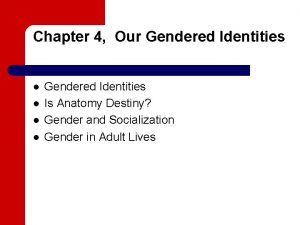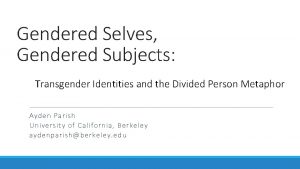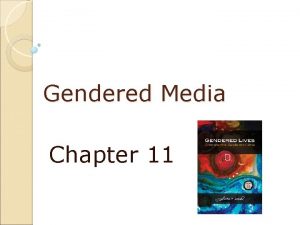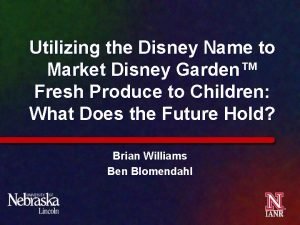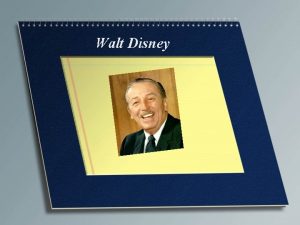A Quantitative Analysis of Gendered Compliments in Disney





















- Slides: 21

A Quantitative Analysis of Gendered Compliments in Disney Princess Films Carmen Fought, Pitzer College Karen Eisenhauer, North Carolina State University


The perils of qualitative research… “…Ariel and Jasmine, who choose to marry their heroes, do so not simply to obtain husbands, but as an exercise of their regal prerogative, irrevocably changing the status quo by choosing a consort contrary to accepted norms. ’ (Do Rozario 2004) “The film initially posits Ariel’s fascination with land as cause for leaving the ocean, but in the style of backlash politics, it eventually channels her struggle for independence and autonomy into the more traditional, narrow goal of choosing a husband. The narrative commandeers her desire into a desperate teenage romance; (Stover 2013)

Why Disney? “Animated films appear to inspire at least as much cultural authority… for teaching specific roles, values, and ideals as do more traditional sites of learning (Giroux, 1999) Disney Princess Franchise Founded in 1990 s, currently has 13 princesses and $4 billion net worth

In what ways do Disney Princess films use language to characterize gender differences?

How do the films’ linguistic depictions of gender compare to gendered patterns of speech in real communities?

Has there been any change in how gender and language are portrayed in Disney films over time?

Three Princess Eras Classics Era 1937 -1959 Renaissance Era 1989 -1999 New Age Era 2009 - Snow White 1937 Cinderella 1950 Sleeping Beauty 1959 The Little Mermaid 1989 Beauty and the Beast 1991 Aladdin 1992 Pocahontas 1995 Mulan 1997 Princess and the Frog 2009 Tangled 2010 Brave (Pixar) 2012 Frozen 2013

Gender in Disney Gender is generally portrayed as binary, uncomplicated, heteronormative All films except Aladdin star women, but they are populated overwhelmingly by male characters Character Counts for Disney Princess Films Male Female 35 30 25 20 15 10 5 0 ) ) ) 12 13 10 98 95 92 09 57 91 50 89 20 20 20 19 19 ( ( ( g e n n lla it tas ast aid din led uty ula rav Fro oze on ng Be ad r B ea rm ere M Wh l d h a F B e d e A n T w M a ca th Cin ing le Po Sno ess nd ep c itt a e n L l S ty Pri au Be ) 37 19 e(

Classics Era: Male vs. Female Speech 80% 71% 70% 59% 60% 50% 50% 41% 40% 29% 30% 20% 10% 0% Snow White (1937) Cinderella (1950) Male Female Sleeping Beauty (1957)

Renaissance Era: Male vs. Female Speech 100% 90% 80% 77% 76% 71% 68% 60% 50% 40% 32% 30% 29% 24% 23% 20% 10% 0% Little Mermaid (1989) Beauty and the Beast (1991) Aladdin (1992) Male Female Pocahontas (1995) Mulan (1998)

New Age Era: Male vs. Female Speech 80% 76% 74% 70% 59% 60% 49% 50% 52% 41% 40% 30% 26% 24% 20% 10% 0% Princess and Frog (2009) Tangled (2010) Male Brave (2012) Female Frozen (2013)

Compliments “A speech act which explicitly or implicitly attributes credit to someone other than the speaker, usually the person addressed, for some ‘good’ (possession, characteristic, skill, etc. ) which is positively valued by the speaker and the hearer” (Holmes 1986) Types of compliments Appearance “She’s mighty Pretty. She’s beautiful!” (Dwarves, Snow White) Ability, Performance, or Skill “You…. . You fight good. ” (Shang, Mulan) Possessions “This is quite a remarkable device. ” (Sultan, Aladdin) Personality, Friendliness “He’s really kind and gentle…. He’s my friend. ” (Belle, Beauty and the Beast) General, Other “Some people are worth melting for. ” (Olaf, Frozen) Foundational studies: Wolfson (1983), Holmes (1986, 1998) Parisi & Wogan (2006), Rees-Miller (2011)

Methodology Compliments pulled from script (Songs excluded), along with gender of speaker and recipient Edited by second coder, conflicts resolved “Weeded” controversial compliments by third coder, conflicts resolved Edge cases excluded

Results Male Giver Female Giver Male receiver Female receiver 32% Holmes (1986) (n=155) 68% (n=329) 26% (n=126) 74% (n=358) n = 484 Parisi et al. (2006) 29% (n=65) 71% (n=158) 30% (n=68) 70% (n=155) n = 223 Our Results 67% * (n=244) 33% * (n=122) 54% ** (n=197) 46%** (n=169) n = 366 * p<0. 001 ** n. s. TOTAL

Comparison with Parisi & Wogan 2006 (From Parisi & Wogan 2006) TOPIC Female-Male Appearance* Male-Female Male-Male Female-Female 25% (18) 33. 61% (40) 12. 8% (16) 44% (22) 27. 78% (20) 27. 73% (33) 60% (75) 30% (15) Possessions 5. 56% (4) 6. 72% (8) 0. 8% (1) 6% (3) Personality 23. 61% (17) 12. 61% (15) 11. 2% (14) 14% (7) Other 18. 06% (13) 19. 33% (23) 15. 2% (19) 6% (3) 72 119 125 50 Skill** Total Compliments * p<0. 005 ** p<0. 001 Other categories n. s.

Are female characters more likely to receive compliments on their appearance than on their skills? (Is this trend reversed for males? Does this change over time? ) Are female characters more likely than males to receive compliments on appearance? Is the trend reversed for skill? Does this change over time?

Results: Appearance vs. Skill Female Receivers: Appearance vs. Skill 60% Male Receivers: Appearance vs. Skill 60% 55% 50% 42% 40% 38% 40% 30% 23% 26% 24% 22% 20% 13% 11% 12% 10% 0% Classics Renaissance appearance skill New Age 0% Classics Renaissance Appearance Skill New Age

Results: Men vs. Women Appearance: Men Vs. Women 90% 80% Skills: Men Vs. Women * [VALUE] 70% 80% 70% * [VALUE] 60% 50% 39% 40% 30% 22% 20% 10% 0% 0% men * p<0. 001 43% New Age 17% Classics women *p<0. 03 43% 30% 20% Renaissance 57% 40% 30% Classics * [VALUE] 90% Renaissance Men *p<0. 001 n. s. New Age Women *p<0. 001 n. s.

Future research Responses to compliments Unstructured vs goal-oriented settings Other discourse features: directives, insults, apologies, questions Qualitative Pixar Men data: what are compliments used for? and the “so many dudes everywhere” effect and masculinities in detail

Thank you!!!! Carmen Fought: cfought@pitzer. edu Karen Eisenhauer: kreisenh@ncsu. edu References available on request
 Carmen fought and karen eisenhauer
Carmen fought and karen eisenhauer Becoming gendered
Becoming gendered Hyper heterosexual feminine identity
Hyper heterosexual feminine identity Gendered verbal communication
Gendered verbal communication Importance of compliments
Importance of compliments Compliments and congratulations
Compliments and congratulations Indirect compliment
Indirect compliment Text generators
Text generators Cognitive interview
Cognitive interview American idol
American idol Compliments will get you nowhere
Compliments will get you nowhere Ticket compliments
Ticket compliments Van bergen kit number
Van bergen kit number Disney product mix
Disney product mix Quantitative analysis definition
Quantitative analysis definition Qualitative and quantitative data analysis
Qualitative and quantitative data analysis Quantitative estimation of protein
Quantitative estimation of protein Quantitative immunohistochemistry image analysis
Quantitative immunohistochemistry image analysis 02022009
02022009 Who is pictured above?
Who is pictured above? Concept application frq ap gov examples
Concept application frq ap gov examples Quantitative analysis for management excel qm
Quantitative analysis for management excel qm
